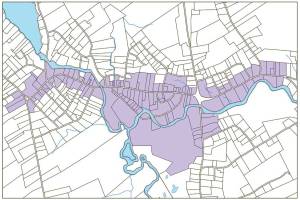Questions linger on downtown zoning changes
By Gail Geraghty
Staff Writer

KEEPING IT COMMERCIAL — The parcels shaded in yellow on this downtown Bridgton map currently contain businesses. The dots indicate parcels of 20,000 square feet or greater in size, which would be required to maintain a retail or professional use on the ground floor under a proposed amendment to the Site Plan Review Ordinance.
Bridgton municipal officials are still awaiting word on the legality of proposed changes to the Site Plan Review Ordinance designed to ensure that the ground floor of downtown buildings on lots 20,000 square feet or larger are used for business purposes and not as living space.
The Bridgton Planning Board will hold a public hearing next Tuesday, March 20, at 7 p.m. on the amendment, as endorsed and brought forward by the Comprehensive Plan Committee. The change would require property owners, on 20,000 square feet or larger lots in a newly-defined Village Center District, to maintain a mixed use on any new development or expansions over 25%, with the ground floor reserved for retail or professional use only. Home occupations would be exempted, and existing uses would be grandfathered, providing no change of use occurs.
The boundaries of the new Village Center District encompass the properties around the monument at Main Hill, down along Main Street to include all of Depot Street and the former Memorial School site, and beyond the intersection at Pondicherry Square up Portland Road to Maple Street, and down lower Main Street to the Kansas Road. According to research conducted by Comprehensive Plan Committee member Glen “Bear†Zaidman, the district includes at least 38 parcels of 20,000 square feet or greater. Most of those parcels are currently used for business, but not all — at least a half-dozen are used as residences along lower Main Street, and several lie within the heart of the downtown.
At the request of the Bridgton Planning Board, Town Administrative Assistant Georgiann Fleck has asked the Maine Municipal Association’s legal department to rule on the legality of a retroactivity clause in the amendment that makes the change effective as of Feb. 20, 2012. Avesta Housing, Inc. has not yet submitted its plans for a three-story, all-residential, affordable housing complex on the 29,000-square-foot former Chapter 11 property in Pondicherry Square, but the agency plans to have its first review of the plans at the board’s April 13 meeting.

DEFINING A VILLAGE — This map shows the boundaries of a proposed new Village Center District, where the ground floor of any new or renovated buildings would be restricted to retail or professional use on lots of 20,000 square feet or greater in size. Home occupations would be exempted. The amendment will be reviewed at a public hearing before the Bridgton Planning Board on Tuesday, March 20, at 7 p.m.
The board wants legal advice on how to proceed with reviewing the Avesta project, or any other affected project, prior to consideration of the amendment by voters at the June Town Meeting. They also want to know whether a housing project such as that proposed by Avesta would be considered a commercial use. Avesta plans to build 19 one-bedroom and 2 two-bedroom rental units on three stories, and rent the apartments to elderly or disabled persons who are income-eligible to receive low-income housing assistance.
The town had not received a reply from MMA by presstime Wednesday, but is expected to have an answer to its questions by next Tuesday’s public hearing. The town’s Site Plan Review Ordinance currently defines “commerce†as “the exchange or buying and selling of commodities on a large scale involving transportation from place to place,†and defines “commercial†as “connected with the buying or selling of goods or services or the provision of facilities for a fee.â€
At the planning board’s March 6 meeting, Code Enforcement Officer Robby Baker pointed out a potential conflict in the Site Plan Review Ordinance regarding dimensional setback requirements for commercial uses, which also needs legal clarification by the MMA.
DEP appeal on track
In a related matter, Town Manager Mitch Berkowitz said Town Attorney Richard Spencer is currently drafting the language for the town’s formal appeal of the Department of Environmental Protection’s corrected order outlining a 5,000-square-foot minimum lot size in the Shoreland Zone for the downtown’s General Development I and II Districts.
The town wants that minimum lot size reduced considerably, in part because, under the current order, Avesta Housing cannot proceed with its plans as proposed. Berkowitz said Baker has documented for the appeal cases of several Maine communities, where the DEP allowed a zero minimum lot size in order to accommodate special local needs, such as a vacant mill building up for redevelopment as condo or apartment housing.
The town has requested a hearing before the Board of Environmental Protection, but before that takes place, Berkowitz said the town hopes to have “a full and rich discussion†with DEP officials as well as a representative from the state’s Attorney General office that has been advising the DEP.
“The issue of what they will and will not allow is tricky — on its face, it sounds like we won†when the DEP agreed to correct its order to reflect the exact language approved by voters at a Dec. 13 referendum. But that language requires a 5,000-square-foot minimum lot size, which he said isn’t low enough to create viable redevelopment projects, “regardless of which parcels you’re talking about,†whether it be the former Chapter 11 property or the ailing Mcdonald family buildings in Pondicherry Square.
Berkowitz said he is also concerned that the proposed amendment to the Site Plan Review Ordinance, concerning ground floor commercial uses, could unduly restrict redevelopment options in the downtown.
“They’ve added an additional burden to developers†under the amendment by restricting options on allowed uses on the first floor, he said. Given the amendment’s retroactivity clause, he said, it appears clear that what is really motivating the change is an attempt to kill the Avesta project. Amendments that attempt to restrict a specific type of development — such as the citizen’s referendum to prevent big box stores or fast food restaurants — are not looked on kindly by developers, he noted, and can impact existing property owners or businesses in negative ways.
“They did not want to have that kind of targeting†with the McDonald’s project, which is one reason why the referendum was rejected by voters, said Berkowitz.
“When you start restricting that mixed use in parcels, does that contravene what you’re trying to do for the whole? When you start piecemealing, I get a little concerned,†he said.

